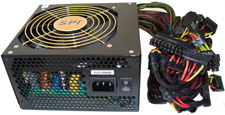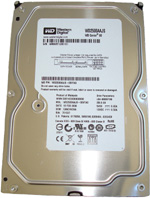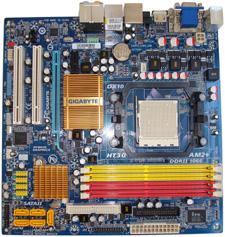Computer Assembling
Tuesday, January 28, 2014
Expansion Cards
Expansion card
Alternatively referred to as an add-on card, expansion board, internal card, interface adapter, or just card. An expansion card is an electronic board or card added into theexpansion slot of a desktop computer or other non-portable computer to give that computer a new ability, such as the ability to connect to another computer using a network cable.
Types of expansion cards in a computer
- Interface card (ATA, Bluetooth, EIDE, Firewire, IDE, Parallel, RAID, SCSI, Serial, and USB)
- Modem
- MPEG Decoder
- Network Card
- Sound Card
- Video Card
- Video capture card
Expansion card example
Below is a graphic illustration of an ISA SCSI card. As can be seen by the below illustration, this adapter would enable users to connect Internal and external SCSI drives into their computers.

As can be seen by the above illustration, expansion cards are keyed, which means they will only go in one direction, and only into the expansion slot the card was designed for. On the backs of every expansion cards is also a back slot that allows computer components to plug into the card and interface with the computer.
Related pages
- How do I install an expansion card?
- How do I remove an expansion card in my computer?
- How do I open my computer case?
Also see: Adapter, Expansion slot cover, Expansion, Expansion slot, Hardware definitions, PC Card,Rese
Hardware
Getting the computer case ready

Lay a soft cloth on a table big enough to accommodate the case, monitor, keyboard and speakers. Make sure that power supply can be reached. Remove case from packing box, making sure not to scratch case or destroy packing that will be recycled in shipping. Keep all packing materials back in the packing box. Place case on table. Unscrew the screws at the back of case and remove left and right side panels. Remove one dvd cover from the front panel. In some cases you may have to remove the front panel by pulling under the bottom of the front panel.
Remove the instruction manual if any and extra screws packet from the case. Place the manual in a manila folder. Do the same for all paperwork that comes with all components. The contents of this folder will be sent with the computer to the customer at delivery. Keep the extra screws packet handy for use. When it comes to which screws to use where, because the different screw sizes look very much alike, use the size that fits best! Tip - generally the hard drive screws are a bigger size. The PSU screws are also the same size but sometimes have a bigger head.The DVD screws are smaller. Motherboard screws may be the same as the hard drive or DVD.
Install power supply unit (PSU)

MAKE SURE VOLTAGE SWITCH ON PSU IS SET TO RIGHT VOLTAGE FOR YOUR COUNTRY! Stand the case. Position power supply unit in its place in the case rear with the power socket facing outside and its fan side placed appropriately based on case design. Fasten 4 screws that came with case through rear of case into PSU to hold PSU in place. Tighten all screws in the assembly with fingertips force only on the screwdriver to avoid over tightening and potential damage.

Install hard disk drive (HDD)
You may prefer to use plastic holders to secure your hard drive, a screwless design offered in some cases, but I feel screws give you a better hold. Insert the hard drive into one of the 3.5 inch internal bays for hard drives in the case, making sure the label side of the drive faces up, and the hard drive connectors face into the case. Push in the hard drive so the screw holes on each side of the hard drive line up with the holes on the drive bay of the case, and the hard drive rests on the small ledges inside the drive bay. Fasten 4 screws to these holes, 2 on each side, to secure the hard drive to the drive bay.
Install DVD drive, and memory card reader (optional)

Remove from the front panel of the case the plastic holders from the external 3.5 inch drive bay (if installing a card reader), and also from the top external 5.25 inch drive bay for the DVD drive. Remove any steel grills from the entrance of these bays on the case so you can slide the drives in. Snap back the front panel onto the case. Slide the Card Reader into the external 3.5 inch drive bay, from the front of the case. Slide it in so it is level with the front panel. Fasten with screws on each side.
Slide DVD drive into top external 5.25 inch drive bay, from the front of the case. Slide in so it is level with the front panel. Fasten with 8 screws, 4 on each side.
Install motherboard

DO NOT SCRATCH MOTHERBOARD TO AVOID POTENTIAL DAMAGE TO ETCHINGS ON MOTHERBOARD
Lay case on its side with open side facing up, back of case (input/outputs) closest to you. Drape all long wires including PSU wires outside case, making sure not to scratch case. Install the metal input output shield that came with the motherboard with the three vertical round holes on the shield to your right when facing the case. Install new shield by snapping along edges till small points take hold.
Screw 6 motherboard hexagon stud screws, that came with the case, into the case. Some motherboards may take more screws, check your motherboard first. Use the 6 holes that are marked on the case for the micro ATX case size that match the holes on your motherboard . Tighten with a motherboard hexagon tool or similar tool. Test which size screw that came with the case to use into the hexagon studs before placing motherboard on the studs. It's hard to get out the wrong sized screw if the motherboard is in place. Place motherboard on top of the studs. Fasten 6 of those screws through the motherboard into the studs to fasten motherboard. Use a Phillips head screwdriver that sticks to the screws so the screws do not fall on the motherboard. Again, careful that the screwdriver or screws do not scratch motherboard. Tighten screws with fingertip force only to avoid damage. Also, remember at some point in the future you may want another motherboard and you don't want a nightmare unscrewing overly tightened screws.
Install processor (CPU), CPU heat sink and CPU fan
Follow any installation instructions that came with cpu. They are usually as follows. Handle CPU with care touch only by the sides! Don't touch the socket! Lift CPU lever, align gold triangle on cpu with right angle drawn on the motherboard at one corner of the cpu socket, aligning the two notches on the cpu sides with the cpu socket, place cpu in socket and lock CPU lever.
Follow any installation instructions that came with cpu heat sink and cpu fan. They are usually as follows. Place heat sink and CPU fan on CPU making sure CPU fan wire is on the side with easy access to the CPU fan header on motherboard. Make sure thermal paste material on heat sink is not wiped off by placing on another surface. Connect the heat sink connectors to the motherboard per instructions from the cpu manual, usually it's just push in the connectors to lock it to the motherboard. Connect CPU fan to CPU fan header on motherboard.

Install memory
Insert memory sticks in the dual channel memory slots. Make sure the notch on the memory sticks match the notch in the DIMM slots before inserting them. Make sure you insert them all the way into the DIMM slot. This usually causes the clasps on the top corners of the slots to click in and lock the memory sticks in place. If this doesn't happen make sure the memory sticks are all the way into the slots and then manually lock in the clasps.
Clear CMOS
Clear CMOS memory with the CMOS header. Refer motherboard manual for motherboard diagram to find all jumpers, headers, other connectors locations on motherboard and these instructions.
Connect power to motherboard
Plug in 20 + 4 pin main power connector from the PSU to the main power slot on motherboard. The pins shapes match the pin sockets and can only be inserted one way. The clasp on the connector will direct you.
Connect power to CPU
Plug in 4 pin CPU power connector from the PSU to the CPU power slot on motherboard. Make sure to connect by matching pin shapes on connector to pin sockets on motherboard. The clasp on the connector will direct you. If you use a more powerful PSU this CPU power connector will have 8 pins, no problem just connect 4 of the pins, again the shape of the pins and the clasp will direct you which 4 pins to use and the direction it plugs in.
Connect case wires to motherboard
Connect case wires: power switch/reset switch/power led/hdd led/speaker pins (if case has a case speaker) to front panel header on motherboard. Refer motherboard manual for pin orientation. A small triangle on the side of a pin means positive.
Use plastic ties provided with the case to tie these wires to the case, if needed, to reduce motherboard wire clutter and increase airflow.
Connect case front panel USB 3 to motherboard
Connect case front panel USB 3 cable from case to a USB 3 header on motherboard. If your case has only a front panel USB 2 jack connect to a USB 2 header.
Connect case front panel HD audio to motherboard
Connect case front panel HD audio cable from case to front panel audio header on motherboard.
Connect memory card reader USB cable to motherboard
If using a memory card reader connect the card reader USB cable to another USB header on motherboard.
Connect case fan to motherboard
Connect case fan to case header on motherboard. Remove the molex adapter (if any) it is not required.
Connect power to HDD and DVD
Connect a power rail with SATA connectors from PSU to HDD. Connect the other power rail with the SATA connectors from PSU to DVD.
Connect SATA cables from motherboard to HDD and DVD
Connect SATA cable that came with the motherboard from motherboard SATA3 header to HDD. Use straight shaped SATA connector on HDD side. Connect SATA cable that came with the motherboard from motherboard SATA3 header to DVD. Use L shaped SATA connector on DVD side.
Install video card

Adding this section for the CurrentBuild Dream PC which uses a separate video card. Remove from the case's rear the metal bracket corresponding to the motherboard's PCI express x16 slot, by unscrewing it. Insert the video card into this PCI express x16 slot, making sure again you don't scratch the motherboard with the video card's metal bracket or other part. Screw the video card's metal bracket to the case rear to fasten it.
If the video card has a power connector, connect from the PSU a six pin PCI express power connector to this video card power connector.
Tie wires
Tie PSU rails and other wires around the inside periphery of the case as much as possible to keep motherboard uncluttered. Tuck extra rails and connectors into empty external 5.25 and 3.5 inch drive bays. Use ties as appropriate.
Place CurrentBuild Sense PC logo label on case
Place CurrentBuild Sense label sticker at center and top of front panel.
Plug in power supply cord
Plug PSU cord into PSU and wall outlet and start computer. Use usual precautions when handling electricity!
Test connections
Test to see the following are running - all 3 fans (case, CPU, PSU), power button, reset button, speaker beep (if case has a speaker), PLED light, HDD led light, DVD led light.
Screw back case left and right panel
Screw back left and right panel with thumb screws.
More testing
To test CPU/memory/motherboard/hard drive/DVD/PSU/case/keyboard/mouse/audio - connect the monitor, keyboard, mouse, internet jack and speakers to the computer and install the operating system.
Install Linux or Windows 8.1 operating system (OS)

Enter BIOS by tapping the delete key immediately on starting the computer. Update the date and time. Under Storage configuration or other similar heading make sure SATA Type is set to 'AHCI'. This setting is for Linux, Windows 8.1, 8, 7 and Vista. This is the default setting nowadays - 'AHCI'. For Windows XP set SATA Type to 'IDE'.
Under Boot options make First Boot Device 'DVD RW' or your DVD option, and Second Boot Device 'Hard Drive' or your hard drive option.
Under chipset configuration or other similar heading make Primary Graphics Adapter - 'Onboard', unless you are installing a separate video card in which case it should be PCI Express.
Make other changes to BIOS as desired. Look through each menu and change as desired. Save settings and exit BIOS.
Install Linux or Windows 8.1 with an installation DVD from the DVD drive. For Windows you have to buy the installation DVD. For Linux, download the Linux distribution you want to install onto another computer and then burn that iso image file to a DVD to create your free Linux installation DVD. Just follow the directions once the installation DVD loads on your newly assembled PC to install the operating system. For Windows place Certificate of Authentication sticker on case rear. After installation of the OS is complete remove the DVD from the DVD drive, enter BIOS and change the boot order back to 'Hard Disk' first and 'Disabled' second. Restart PC!
Update BIOS
Update the BIOS from the flash utility in the BIOS itself. The new BIOS will reset all changes in the BIOS back to default settings, so make changes again in the BIOS as desired.
For Linux - Updates
Use Update Manager or equivalent to download and install all improvements, security fixes and software patches for the OS and the software packages or apps that come pre-installed with the OS.
For Linux Mint 13, which is the LTS version (long term support release) you can backport or update improvements from newer releases by following these instructions from the Linux Mint website. To add the backports in Linux Mint 13, follow the steps below:
- Open the “Software Sources” tool from “Menu -> Preferences -> Software Sources”
- Click on the “Backported packages (backports)” checkbox
For Windows 8.1 - Create a drivers folder
Create a new folder called CurrentBuild on the hard drive. Under CurrentBuild create a separate sub folder for each driver and utility to be installed. Copy the latest separately downloaded or otherwise provided driver or utility installation file to its respective sub folder. Double click on each installation file in each sub folder to extract files and start installing in the order below.
For Windows 8.1 - Install drivers
Install latest motherboard chipset drivers downloaded separately from motherboard website.
Install VGA Driver downloaded separately from the motherboard website. Do a custom install so you remove any marketing/promotional software if not wanted.
Install latest HD audio driver downloaded separately from motherboard website.
Install latest LAN driver downloaded separately from motherboard website. Connect RJ45 cable from your DSL or cable modem to the RJ45 jack in the computer back panel. LAN should now be working and the computer connected to the Internet.
For Windows 8.1 - Install antivirus software and utilities
Install antivirus program from motherboard CD and update it from antivirus program's website, or download and install free Microsoft Security Essentials, Microsoft's free antivirus and anti spyware package.
Install CPUZ utility downloaded from CPUZ website and check CPU and memory performance.
For Windows 8.1 - Updates
Use Windows Update to download and install all security fixes and software patches for the OS.
Install monitor driver for your monitor if Windows update does not install it for you, and also keyboard and mouse drivers if needed for certain keyboards and mice.
For Windows 8.1 - Install software programs
Download and install latest version of Firefox, Adobe Reader, Adobe Flash Player and Java from respective websites.
Even more testing
Play audio CD to test. Insert memory card into memory card reader to test if installed. Insert flash drive or other USB device into USB port(s) to test. Let system run for 12 hrs. Wipe down and clean case with moist cloth.
Pack
Place case in plastic bag and encase corners with foam packing recycled from original packing. Then place in original box and seal.
Monday, January 27, 2014
Subscribe to: Posts (Atom)






















No comments:
Post a Comment